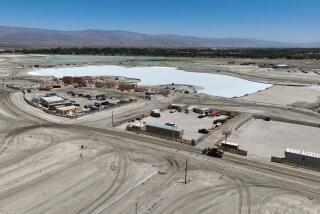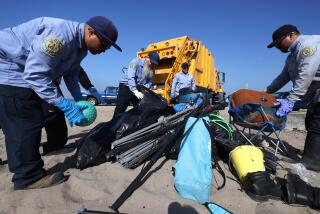Lifestyle Gives Seaside Enclave Its Charm : Playa del Rey: Airport noise endured as trade-off for area described as friendly and fun.
- Share via
When United Airlines stewardess Linda May was still single and living in an apartment in Playa del Rey, she recalls telling a friend that any man she married would have to live in the area because she was never going to move.
These days her destiny is rapidly unfolding as the home she shares with her husband of two years, retired pilot Rex May, is nearing the completion of a five-month remodeling job. Typical of many of their neighbors in the Lagoon section of Playa del Rey, the Mays “went up” to create more space. The result has given their three-story, 16-year-old house a high-tech look, an extra story and a deck with a view of the northern marina.
Remodeling costs, which started out at $62,000, came to over $200,000, May acknowledged with a small swallow. Then she matter-of-factly explains that as her husband approached mandatory retirement, they considered moving to Palm Springs or North San Diego County. But they decided to remain in Playa del Rey because “Look what we’ve got. It’s a quality of life.”
Needless to day, May’s excitement is fueled by more than just the thrill of watching her 2,200-square-foot “tall skinny” rise high above sea level.
“It’s a fun area,” says May, who runs on the nearby beach every day. “There is a lot of walking. From where we live you can walk to 14 restaurants. We’ve got our Neighborhood Watch and Vista del Mar Neighborhood Assn. People live here for a long time. It’s very friendly.”
Like its northern neighbor Marina del Rey, the small ocean-side community of Playa del Rey is part of the city of Los Angeles. And while it is often linked to its eastern neighbor, Westchester, and referred to as Westchester-Playa del Rey, residents view their locale as separate and distinct.
Several diverse neighborhoods make up Playa del Rey. Single-family homes on “The Hill” cover an enormous rise that had once been a sand dune, where the area’s first homes were built. Frequently featuring ocean and city views, they are within walking distance of the water.
Acquiring its name from the channel that lies north of Culver Boulevard, “The Lagoon” area is a blend of homes, duplexes, apartments and condominiums. North of Culver Boulevard lies “The Jungle,” a nickname for the large concentration of apartments that flank the beach. “The Condos” lie in the southeastern corner of the region and make up at least half of Playa del Rey’s housing.
Prices start at $350,000 for an original 1950s two-bedroom, one-bath house, said real estate agent Paul Aguirre, with Jon Douglas Co. A high-end bluff property with 5,000 square feet and five bedrooms, four baths, entertaining floor, second kitchen and elevator sold earlier this year for almost $1.8 million.
“All homes are on good-sized lots,” said Aguirre. “The differences are in location and updating.”
The lowest price condominium lists for $126,000 at the Tuscany Villas complex, said Mike Work of Remax Realty; the top list price is $1.95 million for a penthouse on Ocean Front Walk near the lagoon.
Frank Velasco discovered Playa del Rey in his student days at Loyola University in Westchester. Then when the psychologist and his attorney wife, Val, began shopping for their first home, his appreciation of the community was heightened by its surroundings.
“It was almost like this little peninsula,” said Frank Velasco. “You can’t get to Marina del Rey from here--you have Ballona Creek. So the land locks on the north side. On the south side we have the buffer zone from the airport--there is nothing there. We like being close to the beach. We just fell in love with Playa del Rey because of its location.”
Five years ago the couple bought a 1,600-square-foot, three-bedroom fixer-upper just blocks from the water. Said Val Velasco, “It was a wreck. It had been ignored for a long time. We really wanted to live in the area. Since the house was a fixer-upper, it became a reality.” They paid $324,000; the house is now valued at $500,000.
Learning to live with the airplane noise that arises from their proximity to Los Angeles International Airport has been a struggle at times, the Velascos said. “The planes are supposed to fly out over the ocean, over the unhoused areas,” Val Velasco said. “The airport has a hot line. You’re supposed to call and identify the plane. We have our list that tells what each plane looks like and what it is called. We would call so often. We’re sure nothing was ever done.”
This irritant, however, hasn’t diminished their enjoyment of a neighborhood with lots of families and children. “Our son has finally learned how to ride his bike,” said Val Velasco. “It has been really neat to walk three blocks to the bike path and start going in either direction.”
The thought of leaving their home in Westchester hadn’t seriously occurred to interior designer Nora Tertzag and her husband, Herb, 23 years ago. But they made up their minds quickly upon seeing a 3,300-square-foot custom home in Playa del Rey for the first time. Said Nora Tertzag, “I liked all the glass and the ocean view. It was very light, bright and airy. I just loved it.”
After she talked her husband into putting their former home up for sale they accepted the first offer and found themselves ensconced in their new home one month later. “It was incredible,” she recalled. They paid $55,000.
A lack of congestion, easy freeway access and cool temperatures have remained to her liking. “I think the reason we really came here was the weather,” she said. “You never need air-conditioning. It’s a perfect climate.”
*
In 1903 Playa del Rey was a favorite stop on the Pacific Electric Railway “Balloon Trip” for tourists. After a period of heavy expansion, there was much to see: A $100,000 pavilion, an 18-mile speedway for automobile racing and the $200,000 luxury Del Rey Hotel were some of the attractions.
But when fire destroyed the hotel and pavilion, the popular resort went into a decline and not until the mid-1920s would developer Fritz Burns begin planning “Palisades del Rey” and “Surf-ridge” on acreage south of the lagoon. By 1927 a completely paved Culver Boulevard signaled a new era of prosperity.
As the Great Depression hit, the once-lovely lagoon began to suffer from the effects of extensive oil drilling just north of Playa del Rey. Civic committees sought federal funds to buy the lagoon and the fishing pier.
However, as soon as the funds were released in 1936, the Army Corps of Engineers began work on an $8-million flood control channel. Additionally, the dredging of Ballona Creek over the next two years protected Playa del Rey residents from the flooding that occurred during 1938 record rains.
Over the years various local groups have fought to keep the airport from swallowing up the community. By the mid-1970s, however, the area sustained a major loss when LAX took nearly 1,000 homes because of the noise level resulting from their proximity to two runways.
In the last decade Playa del Rey residents have been anticipating the arrival of a new neighbor. Plans for building the community of Playa Vista on open land lying northeast of Playa del Rey and acquired by the late industrialist Howard Hughes in the early 1940s have had a long and turbulent history. Local opposition to a proposal once calling for the construction of high-rises and regional malls contributed to the unseating of a 16-year incumbent city council member and the election in 1987 of the present councilwoman, Ruth Galanter.
In 1989 developer Maguire Thomas Partners assumed control of the project from the Summa Corp., the real estate and development arm of the Hughes organization, and formulated a fresh strategy for developing the 957-acre site. “We realized this wasn’t something that could be done behind closed doors. We had to engage the community every step of the way,” said Maguire Thomas Vice President Doug Gardner.
*
A major bargaining point turned on the firm’s willingness to commit $10 million toward the restoration of 260 acres of wetland that lie on the property. And while Gardner acknowledges that increased traffic remains a problem still being worked on, other solutions are under way.
These have included the purchase of a section of land at the traditionally bottle-necked point of Culver Boulevard and Vista del Mar to improve traffic flow. Blueprints for a waste-water treatment plant, organic recycling system and materials recycling center share in the goal of creating a self-sufficient city-within-a-city.
The environmental impact report on Playa Vista will be ready for review by the end of the summer, said Gardner.
Overall, the dialogue established by Maguire Thomas Partners with Playa del Rey residents has paid off in widespread support. In fact, homeowner Joaquin Acosta, who lives on the west-facing bluffs with his wife, Francis, is impatient for construction to begin. “When I want to buy a nice suit I go to Century City,” he said. “Why can’t I go around the corner to a nice store? Because there isn’t any.”
Added Alison Oxman, who purchased a townhome with her husband, Scott, six years ago, “We’re excited about Playa Vista. It’s going to upgrade us a little bit. It won’t be quite the same sleepy town. Playa del Rey is going to have to recognize that Playa Vista is right next door. I like that. I like progressive change.”
At a Glance
Population
1991 estimate: 14,401
1980-91 change: +31.5%
Median age: 38.5 years
Annual income
Per capita: 35,584
Median household: 58,758
Household distribution
Less than $20,000: 8.8%
$20,000 - $50,000: 31.8%
$50,000 - $75,000: 26.4%
$75,000 - $150,000: 26.4%
$150,000 +: 6.6%
More to Read
Sign up for Essential California
The most important California stories and recommendations in your inbox every morning.
You may occasionally receive promotional content from the Los Angeles Times.













